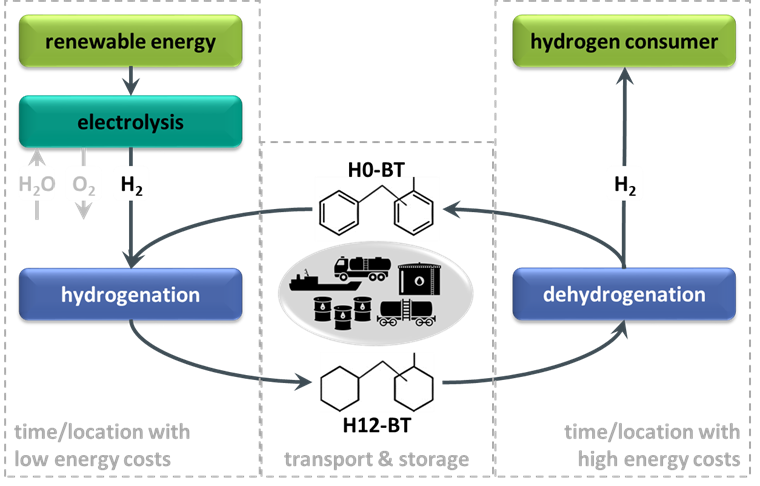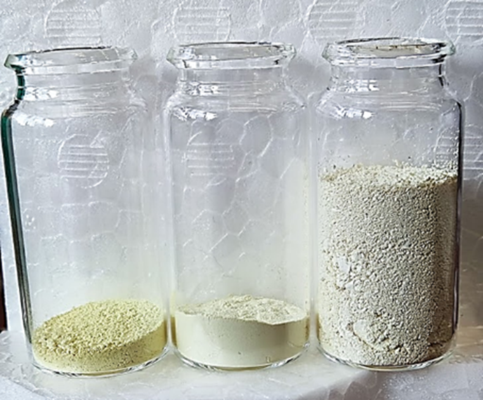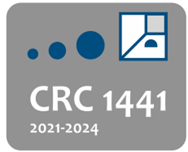Projects
Liquid organic hydrogen carrier (LOHC) technology
The LOHC technology avoids transport and storage of highly flammable molecular hydrogen. Aromatic molecules, such as benzyltoluene (H0-BT) can be reversibly hydrogenated to perhydro benzyltoluene (H12-BT) and dehydrogenated to H0-BT in order to chemically store and transport hydrogen in liquids. These LOHCs are typically non-flammable, have a low toxicity, a wide liquid range as well as a high storage density for hydrogen. Further, this chemical storage of hydrogen may even employ existing infrastructure for liquid fuels (diesel, gasoline) enabling safe and facile global supply chains. However, the technical release of hydrogen requires rather high reaction temperatures due to the strongly endothermic nature of the dehydrogenation reaction. Hence, the main field of research is the release of hydrogen from LOHCs via dehydrogenation. This topic comprises the development and up-scaling of novel catalysts and their application in various reactor concepts. Further, novel process routes towards higher overall efficiencies are investigated.

Circular use of liquid organic hydrogen carriers (LOHCs) for storage and global transportation of hydrogen; ©Moritz Wolf
Novel catalyst materials for CO2 activation
The project aims to identify and investigate potentially beneficial synergies when employing nitrides as support materials in heterogeneous catalysts for the valorisation of CO2. The objective of the research is the development of transition metal (oxide) based catalysts with carbon nitride (modified) carrier materials. The positive effect of C3N4 on catalysis may boost activity, selectivity, or stability, when compared to standard carrier materials. For example, C3N4 with different morphologies are synthesized. Subsequently, the (surface) properties of the produced materials can be modified by a variety of methods (exfoliation, hydrogenation, etching, hydrolysis, etc.). Alternatively, the choice of precursors and the synthesis parameters also have a decisive influence on the resulting functional groups as well as physicochemical and morphological properties. The prepared nitride materials are decorated with separately synthesised uniform nanoparticles resulting in well-defined heterogeneous model catalysts, which are then tested in the conversion of CO2.

Comparison of the bulk density of bulk C3N4 (left), mesoporous C3N4 (middle) and nanosheet C3N4 (right) powders, 1 g each; ©Angelina Barthelmeß
CARE-O-SENE

CARE-O-SENE is funded by the German Federal Ministry of Education and Research (BMBF) and connects seven major German and South African project partners: Fraunhofer Institute for Ceramic Technologies and Systems (IKTS), Helmholtz-Zentrum Berlin für Materialien und Energie (HZB), INERATEC, Karlsruhe Institute of Technology (KIT), Sasol Germany GmbH, Sasol Limited, and University of Cape Town (UCT). Together, we develop optimized catalysts for the production of green kerosene. CARE-O-SENE will play a key role in sustainably transforming industries such as aviation. The goal is to make the production of green kerosene as a fuel alternative economically more attractive. Our contribution to this project is the development and preparation of model catalysts to gain insight und structural dependencies and working principles via advanced characterisation techniques.
CRC 1441 TrackAct – Associated Project

The DFG Collaborative Research Centre CRC 1441 ‘Tracking the Active Site in Heterogeneous Catalysis for Emission Control’ aims to identify and track the nature of the active site, to design and manipulate them from bottom-up across the various length scales, and - on a long-term vision - predict and actively control them during operation. The associated project ‘Inductive heating of catalysts and novel reactor designs’ introduces electromagnetic inductive heating to the CRC, which represents an emerging technology for heat management in catalytic applications. Aside from a huge potential to drive electrification of industrial processes, inductive heating enables process intensification, may increase energy efficiency, and represents a highly dynamic heating concept. In this project, we explore the application of inductive heating for catalytic converters with several scale-bridging approaches from lab-based reactor dimensions to the nanometre scale. One approach is the deposition of separately synthesized noble metal nanoparticles on larger particles or structures, which exhibit a certain magnetic susceptibility facilitating inductive heating. Alternatively, conventional catalysts are decorated with appropriate nanoparticulate materials, such as iron carbide nanoparticles, or physically mixed with bulk structures, e.g. stainless steel beads. Inductive heating will be incorporated in testing facilities for initial conceptual evaluation of developed materials and comparison with conventional heating concepts.
Catalyst shaping
For the technical application of catalysts, the catalyst materials in the form of powders in the micrometer range generally have to be converted into stable three-dimensional geometries in the millimetre range by means of shaping processes. This applies to both bulk catalysts, such as mixed metal oxides, and classic support materials. During shaping, application-relevant properties can be varied and additional components, such as binders, are required for the stability of the shaped bodies. Accordingly, this project is conducting research along the catalyst shaping process chain. Optimization starts with the synthesis of powder materials and their characterization, focusing on the development of different formulations for shaping by classical techniques such as extrusion or tabletting. Finally, processing and stability of the catalyst bodies as well as the catalytic properties in various applications are evaluated, which is in part realized in cooperation with other working groups.
